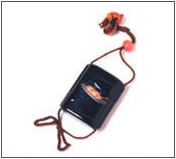Cultural Activities >
Cultural Heritage
What is a Registered Cultural Asset?
A law, enacted on October 1, 1996, that amended part of the Law for the Protection of Cultural Properties, introduced a new registration system for cultural assets. In this new system, buildings of cultural asset which require special measures for their preservation or utilization are registered by the Minister of Education.
This self-report system offers mild protective measures for buildings in the form of instruction, advice, and recommendation. Its purpose is to pass on widely to future generations the large number of buildings of cultural asset, mainly the diverse buildings of the modern era, that are in danger of destruction without having had opportunity for social recognition, due to recent national land development, progress in city planning, and lifestyle changes. It is designed to supplement the narrower existing designating system in which notable assets are carefully selected and approved under strict regulation to qualify for comprehensive protection.
Shoda Shoyu’s Registered Tangible Cultural Assets
[Shoda Inari Shrine]
This Shrine was originally the guardian of Meguruma-cho (present day Sakae-cho), and was entrusted to the Shoda family in 1910.
Since then, it has been enshrined as the guardian god of Sakae-cho and Shoda Shoyu under the name of Shoda Inari Shrine. An annual festival is held on the first day of the horse in February every year. The Shrine consists of the miyashiro, and the honden, or main shrine. The miyashiro is said to have been built prior to construction of the Tatebayashi Castle in 1532, although it is not known for certain. It has been reconstructed twice, in 1828 and in 1859, and stands to present day.
Meanwhile, the main shrine is said to have been designed and built by Masatoshi Mimura, a shrine-building carpenter from Hanyu-machi, in the 1930’s.
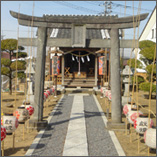
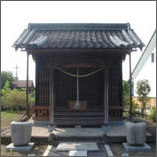
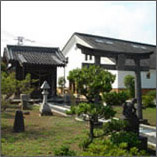
[Shoda Shoyu Library]
The Shoda Shoyu Library is said to have been founded in 1861. It was originally called the Uchikura (internal storehouse). It is a two-story building measuring approximately 4.5m x 3.6m, with sturdy white plaster walls. The roof tiles are decorated with the Kuyo crest of the Shoda Family, as well as the logo for the trade name “Yamato.”
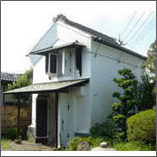
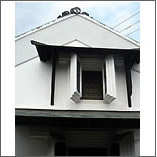
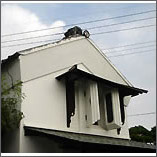
[Shoda Memorial Museum]
Since the “Yonebun” noren (brand) rice trading business that had continued since the Edo Period was changed to the soy sauce brewing business in 1873 by Bun-emon Shoda III, Shoda Shoyu has persistently taken on new challenges to lead the times, never becoming complacent with its present status -- that is, a company with a long history of over 130 years. The Shoda Memorial Museum is a stately wooden structure built in 1853 that exhibits the entirety of this history. Inside are numerous displays of articles deeply associated with the history of the Shoda family and the Company, such as the Shoda family tree dating back 300 years and the brewing equipment used at the beginning of operations, as well as posters from the 1920’s.
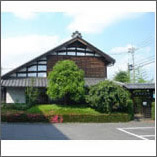
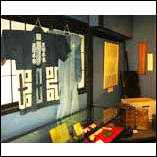
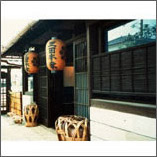
|
Inro (Small lacquered wooden case) The lacquered case used by Bun-emon Shoda II when he traveled to Edo, Osaka, Kyoto, Chugoku, and Nagasaki in 1844. It was used as a handy case for medicines, hung from the waist. It is decorated with a netsuke (charm) of an old man grinding a millstone. |
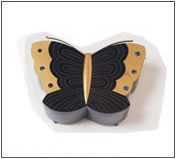 |
Chogata sakana-ire (Butterfly-shaped lacquered wooden boxes) Unique butterfly-shaped food container (tiered boxes), given to Bun-emon Shoda II in 1838 by Inoue Kawachinokami Masaharu, the local lord of the Tatebayashi Clan. |
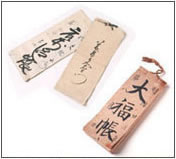 |
Tanaoroshi-cho (Inventory book, left) Inventory records of the rice trader Bun-emon dated from 1806 to 1809. It lists records of barley, soy beans, and wheat, as well as miscellaneous items such as candles and sandals. Daifuku-cho (Account book, right) A book of records, mainly of loans, from the 1830’s/40’s in the Edo Period, when the business was in rice trading, to 1891, when the soy sauce business was started. Due to modernization in management, later books were switched to the Western style. |
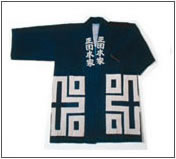 |
Shirushi-banten (Logo jacket) The logo jacket worn during the rice-trading days of the Edo Period. The Chinese character symbolizing “rice,” a part of the trade name of “Yoneya,” is designed around the waist, and the noren (brand) logo “Yamato” is dyed on the back. Regular suppliers to the shop also wore this jacket. |
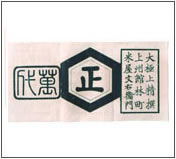 |
Shirushi-hikae (Brand mark notebook) Notebook containing logos of the various brands of soy sauce made by Shoda Shoyu since the beginning of the business in the 1870’s. |
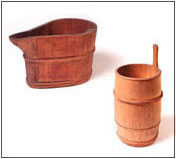 |
Sarubo (Pouring pail, left) Pail used in the Meiji Period (late 19th to early 20th century), for carrying, over the shoulder, moromi* from the fermenting vats to the open tanks in the pressing room, or for carrying the squeezed raw soy sauce. Katate-damari (One-handed carrier pail, right) Pail used in the Meiji Period (late 19th to early 20th century), for carrying, over the shoulder, moromi* from the fermenting vats to the open tanks in the pressing room, or for carrying the squeezed raw soy sauce. |
*Moromi is a fermented mash consisting of a fungus called koji grown on steamed soybeans and roasted wheat, mixed with salt water. It is matured for about six months before being squeezed to yield raw soy sauce.

